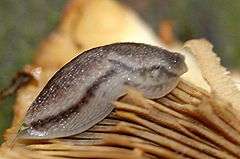Arion circumscriptus
Arion circumscriptus, common name Brown-banded arion, is a species of air-breathing land slug, a terrestrial pulmonate gastropod mollusk in the family Arionidae.
| Brown-banded arion | |
|---|---|
 | |
| Brown-banded arion (Arion circumscriptus), partially retracted | |
| Scientific classification | |
| Kingdom: | |
| Phylum: | |
| Class: | |
| (unranked): | clade Heterobranchia clade Euthyneura clade Panpulmonata clade Eupulmonata clade Stylommatophora informal group Sigmurethra |
| Superfamily: | |
| Family: | |
| Genus: | |
| Species: | A. circumscriptus |
| Binomial name | |
| Arion circumscriptus Johnston, 1828 | |
Description
This slug species is up to 40mm when mature.[1][2] It is listed as 50 mm long in Welter-Schultes [3] It is a roundback slug. Its color is dark grey (sometimes with bluish hue) or brown. The mantle has dark spots. The sides are usually lighter near the foot-fringe, and have one dark longitudinal band on each side; the one on the right runs above the pneumostome. The dorsum often has a very slight keel and the slug is bell-shaped in transverse section when it is contracted. The sole is whitish, and the mucus colourless.
Genitalia: the atrium is large; the epiphallus is heavily pigmented and wider than the vas deferens; the oviduct is short and not narrow; the spermatheca is elongate.[3]
Distribution
Arion circumscriptus is found mainly in the mid and northern latitudes in Europe. The distribution type is European Temperate.
This species occurs in countries and islands including:
- Czech Republic
- Ukraine[4]
- Great Britain
- Ireland
- and other areas. See Fauna Europaea
This species has been introduced in:
Taxonomy
The original description of the three slug species in the subgenus Carinarion, Arion (Carinarion) fasciatus, Arion (Carinarion) silvaticus and Arion (Carinarion) circumscriptus, was based on small differences in body pigmentation and details of the genital anatomy. A 2006 study of these morphospecies (typological species) claims that previous studies had shown that body colour in these slugs may be influenced by their diet, and that the putative genital differences were not confirmed by subsequent multivariate morphometric analyses. Analysis of alloenzyme and albumen gland proteins gave conflicting results. Also there was evidence of interspecific hybridization in places where these predominantly self-fertilizing slugs apparently outcross, contradicting their status as biological species. Molecular studies led to the conclusion that the three members of Carinarion are a single species-level taxon.[7] The name Arion fasciatus has priority.
References
- "Arion fasciatus group: Arion circumscriptus". Terrestrial Mollusc Tool. University of Florida. Retrieved 20 February 2013.
- "Arion circumscriptus Johnston, 1828 Brown-banded Arion". Evergreen State College. Retrieved 20 February 2013.
- Animalbase (Welter-Schultes).
- Balashov I. & Gural-Sverlova N. 2012. An annotated checklist of the terrestrial molluscs of Ukraine. Journal of Conchology. 41 (1): 91-109.
- Land Snails of Pennsylvania Archived 2009-01-23 at the Wayback Machine. accessed 20 January 2009.
- Michigan Department of Natural Resources and Environment. "Brainworm". accessed 14 December 2010.
- Sofie Geenen, Kurt Jordaens, Thierry Backeljau: Molecular systematics of the Carinarion complex (Mollusca: Gastropoda: Pulmonata): a taxonomic riddle caused by a mixed breeding system. Biological Journal of the Linnean Society, 89(4): 589–604, London 2006 doi:10.1111/j.1095-8312.2006.00693.x
External links
| Wikimedia Commons has media related to Arion circumscriptus. |
- Arion circumscriptus at Animalbase taxonomy,short description, distribution, biology,status (threats), images
- Arion circumscriptus on the UF / IFAS Featured Creatures Web site
- "Arion circumscriptus" at the Encyclopedia of Life
